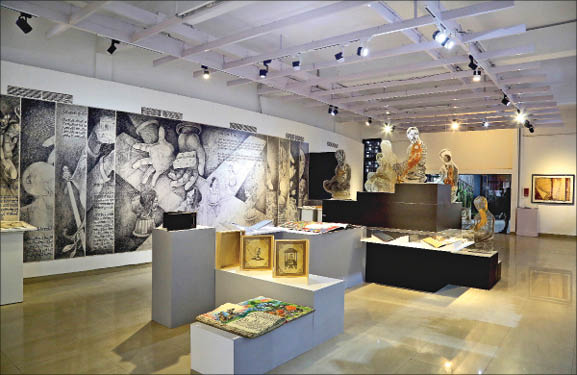Instead of taking the conventional route, several contemporary Indian artists have attempted a unique creative experiment by choosing the art book as their primary medium. These books are on display at an ongoing show in Delhi, writes Bhumika Popli.
The Art Book Exhibition 2019, on view at Delhi’s Shridharani Gallery, has a unique format. Instead of displaying paintings on the wall, the curator has used art books as the focus of the show. Participants include several artists who have used books as their main medium.
The exhibition is organised by Art Heritage and is curated by its founder, Amal Allana. “I grew up surrounded by a number of beautiful art books. I have always felt that art is not something that you hang on the wall but something which you can feel and appreciate from up close. And all these possibilities come in a book form. My whole feeling was that I wanted to give the audience different experiences of art,” says Allana.
The curator is also a theatre director and a stage designer. So she has paid special attention to how space can be utilised in a public showing. She says, “I just want to sensitise the audience to different perceptions that different art forms can give you. To make them understand that a gallery space is not a monotonous series of the same size images and one eye level.”
As a result, the exhibition offers an immersive experience. As you enter the show, you are greeted by a total of 10 huge figures made of plexiglass. This installation, entitled A Book of Our Babu Society, by Rajesh Deb, is a satirical take on the upper-class society of Bengal. On the right, a considerable part of the wall has been covered by a vast panel taken from Gouri Vemula’s book, which is based on the Mahabharata. We see a chapter on the dice game from the epic on the panel. The physical copy of Vemula’s book is also included in the show—filled with her drawings made in pencil, pen and ink.
The artist has made a different drawing on every page of book, with hands as their leitmotif. The adjacent text is in English language but is printed in Samarkand font. This particular font mimics the dynamics of Sanskrit, the language in which the original epic was written.
On the facing wall, we see the artworks by Jai Zharotia. The artist has made 30 acrylic works based on a fictional character, Luqman Ali. This character was penned by Soumitra Mohan, a well-known Hindi poet and novelist.
As you move further in the gallery, you come across Kavita Jaiswal’s paper sculptures. These are foldable objects that can be opened or shut like a book. Included in these book sculptures are several poems written by the artist. She has also made use of texts by great thinkers such as Rumi, Hafiz and Ramana Maharshi. On the pages we see pen and ink drawings made in white colour, reflecting her Zen philosophy that “just like a line, our lives are also in continuous journey without a specific beginning or a fixed end”.
Safarnama by Ravinder Dutt talks about journeys, too. The artist has presented a fictionalised take on the Mughal world by way of wooden structure that resembles a book. On each page we see various miniature drawings which the artist has digitally reproduced by combining his own and borrowed sketches.
“The title and the rendition of the work is in sync with those numerous journeys the Mughals used to take, and the box is made with an impression that it can be packed in a suitcase and carried away. Safarnama talks about how the Mughals planned to safeguard their most prized treasures during a journey,” says Dutt.
On the framed “pages” of his book, Dutt has included images of the peacock throne, gunpowder flask, hukkah, Kohinoor, Taj Mahal and flying carpet among others.
He says, “I have aimed to combine myth and legends in this work. I feel that these things like the Taj Mahal are so beautiful that it was not probably possible for a human hand to make them, and there was something else behind them. I often feel like a time-traveller who goes back to the past and encounters more stories. If I would not have been an artist, I would have been a nomad.”
Rini Dhumal has also recorded her artistic impressions in her four books displayed here. “Whenever I travel to any place I sketch, and after coming back I compile it all together,” she says. In her book The Silk Route of China the artist has attempted to portray the culture and heritage of China. “In the late ’90s, along with a group of artists, we went to a number of art studios on this route to meet contemporary Chinese artists and found many new things about their culture. It inspired me to make this book,” adds Dhumal.
A 2009 text written by K. G. Subramanyan defines Dhumal’s work. “She has an endless curiosity to see the life and culture of places at close quarters. In the last few years, she has visited counties in the East and the West and with each visit has come up with a scribbled record of what has impressed her in each place.”
A number of great artists such as Pablo Picasso and Henry Matisse among others made several art books in their lifetime. This exhibition is a good reminder of that and makes people familiar with this little-known form. The note issued by the gallery points out that the art books displayed here shouldn’t be confused with artists’ sketchbooks. They should be seen as artworks in themselves.
The Art Book Exhibition is on view at Delhi’s Shridharini Gallery located on the premises of Triveni Kala Sangam till 27 January

